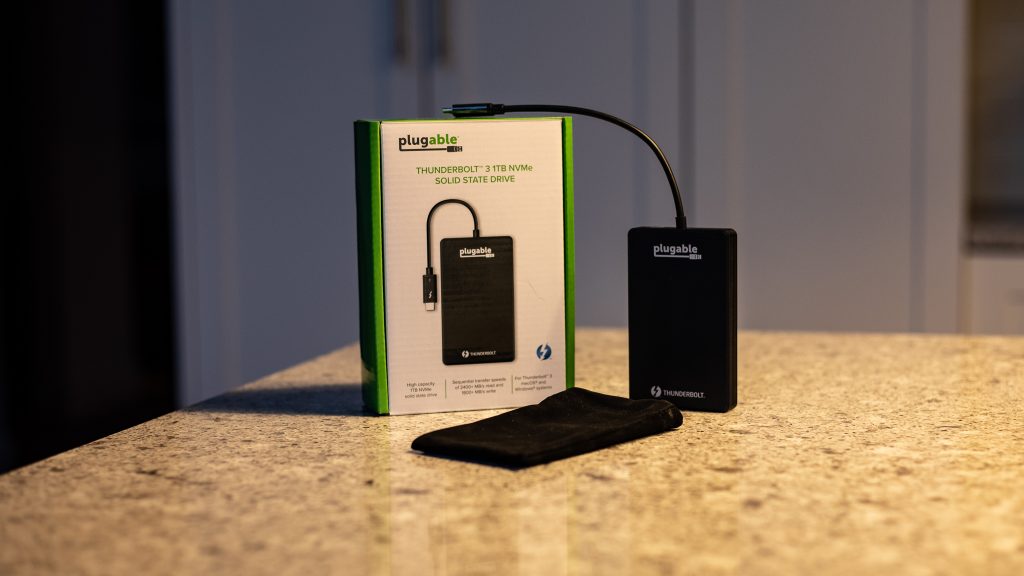Thunderbolt 3 and USB-C portable SSDs have become mainstream as of late, the typical value product having a JMicron controller that provides data transfer speeds up to 1GB/s read and write. This is sufficient for the typical consumer but media professionals demand faster data transfer speeds….and higher capacity. The sweet spot for Thunderbolt 3 is 2.8GB/s and that is as high as she gets. Today we are testing a product that is somewhat an anomaly to the SSD space and that is the Plugable Thunderbolt 3 NVMe external SSD.
We mention this as an anomaly as Plugable has never been known in the SSD space, but rather, can be easily identified for their cable and storage solutions, Thunderbolt 3 being their strong point as of late. I guess this might lead to the reasoning for venturing into the SSD arena. A strong point though is the traditional Plugable marketing approach where they have mass availability at a great price; this could shake things up just a bit.
The Plugable External SSD is available in capacities of 480GB, 1 and 2TB and is a Thunderbolt 3 NVMe 40 Gbps device with advertised speeds up to 2.4GB/s read and 1.8GB/s write (wait for it). It is PCIe Gen 3X4 (4 lane), and is compatible with Thunderbolt 3 or USB-C MacOS, Windows or Linux systems. The drive is pre-configured as ex-FAT for mass compatibility and one may need to turn on or allow Thunderbolt 3 permissions in their BIOS and software for the device to be recognized. This SSD carries a 3-year limited warranty.
Disassembling your Plugable TbT3 SSD will void your warranty, however, it gives us a great vantage point with respect to product quality. First and foremost, we noticed that our exterior packaging listed this device as being a 1TB sample, yet this is clearly marked on the SSD as being a 2TB SSD. The case is a well cut solid black anodized aluminum with a base plate and a fixed external cable. On the green PCB we have the Intel DSL6340 Thunderbolt 3 controller and this PCB houses a generic M.2 SSD with a Phison PS5012-E12 controller and 4 pieces of Kioxia (formerly Toshiba) 64-layer BiCS3 TLC NAND flash memory, each having a RAW value of 512GB.
Pricing for the Plugable Tb3 external SSD is $199 (480GB), $299 (1TB) and $499 (2TB) and updated pricing can be checked on Amazon at this link.
 The SSD Review The Worlds Dedicated SSD Education and Review Resource |
The SSD Review The Worlds Dedicated SSD Education and Review Resource | 


I’m starting to wonder how hard it would be to drop in a Titan Ridge vs. an Alpine Ridge controller. It seems any additional cost would easily be passed to the consumer, as the new device is TB3 with USB3 fallback.
Can you include testing these external TB3 devices after cold boot and hot plug?
Are the speeds identical or different in any way?
I get substantial differences between these two scenarios with the Samsung X5.
It is a given that the test speed would be different, the result of other background activity in the system, especially after a cold boot. We test during ideal conditions and I would be the first to write about it if the tests weren’t always consistent during these conditions. Yopu are also speaking on the X5 in a Plugable report? Are you finding same with this device?
Hi Les, I have performance variations of 3x between cold boot and hot plug with the Samsung 512GB X5 on Windows 10.
I understood this was because TB3 vendors have trouble with the re-negotiation of the Thunderbolt connection after hot plug.
The computer I used is a brand new HP Zbook Studio G5 with Samsung NVMe SSD boot drive running Windows 10 Pro update 1909.
Samsung 512GB X5 Magician benchmarks:
Benchmark #1: 2803/588/263427/25390 after disconnect/re-connect no G2 hub
Benchmark #2: 2806/1877/263427/251220 after cold boot, no G2 hub
Benchmark #3: 2818/589/261474/251220 after disconnect/re-connect with G2 hub
Benchmark #4: 2753/1386/259277/252192 after cold boot with G2 hub
Samsung Tech support confirmed that their tech support center has heard from customers experiencing the same issue.
I also found a lot of variation using TB3 add-in cards from ASUS (ThunderboltEX3), and Gigabyte (Alpine Ridge, Titan Ridge), which is why I wondered if you have tested or found differences in performance with hot plug, in which case it might be a useful test to add. I am definitely disappointed to need a cold boot to get best performance.
Now that you have switched to the ASRock X570 Creator as your test bed, I would like to know if the ASRock X570 motherboard TB3 implementations (Creator onboard TB3 and Taichi+PCI TB3 card) have reliably solved this issue.
Thanks for any help.